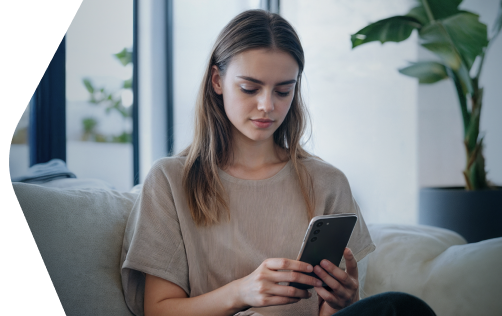How to keep your account from getting hacked
What for: So you don’t get hacked.
If you are using a short and simple password, cybercriminals can guess it and steal your account. A long and complex password is more secure. Use a strong password that:
- Is at least 8 characters long;
- Contains lowercase and uppercase letters, numbers, and special characters ($, @, etc.);
- Is not an actual word or easy-to-guess phrase;
- Is not the same as your passwords for any other accounts;
- Does not consist of information that strangers could easily find out (your name, date of birth, pet's name, and so forth — or those of your friends or relatives).
To change the password:
- Tap your profile picture;
- Select Settings;

- Go to the Account & Profile section;

- Tap Your account to open the account management page in your browser;
- Tap Change password;
- Enter the current password for your Skype account (it’s the same as the password for your Microsoft account);
- Enter the code you receive and tap Confirm;
- Enter your current Skype password;
- Enter a new strong password twice;
- Tap Save.
Note: Your Microsoft account is used to sign in to Skype, so its password will also be changed.
What for: So you definitely don’t get hacked.
Two-factor authentication protects your account even if hackers know your username and password. You will have to enter a one-time code whenever you sign in to your Skype account. The code can be received by text message or e-mail, or generated by an app.
You sign in to Skype with your Microsoft account credentials, so enable two-factor authentication for this account:
- In your browser, open your Microsoft account page at https://account.microsoft.com/;
- Go to the Security section;

- Select Advanced security options;
- Tap Turn on in the Two-step verification section;

- Read the information about two-step verification and tap Next;
- You will be prompted to download Microsoft Authenticator or to set up a different app for receiving authentication codes.
To use Microsoft Authenticator:
- Tap Get it now;
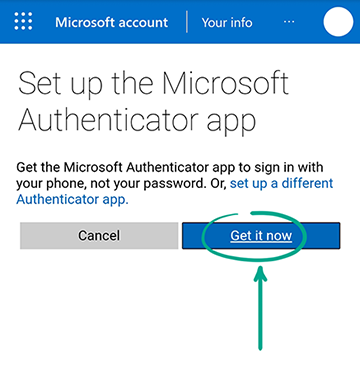
- The download page opens. Tap Get the app and choose a convenient source for your download: Google Play or a link in a text message.
To use a different app, such as Google Authenticator, tap set up a different Authenticator app and follow the instructions.
If you do not want to use an app, you can receive two-factor authentication codes by text message or e-mail. To do so, on the page prompting you to install Microsoft Authenticator:
- Tap Cancel;
- You will be prompted to create a separate password for the Outlook app on your smartphone. This will improve the security of your account (useful if you want to receive the codes by e-mail through mobile Outlook). To create a password, tap the link for your mobile device's operating system and follow the instructions;
- Tap Next;
- If you use other Microsoft services and products, such as an Xbox 360 account or the desktop Outlook app, carefully read the on-screen instructions for creating a temporary password for these accounts. Note: After enabling two-factor authentication, you will not be able to use these services until you create a temporary password for them. You can create or change a temporary password in the Advanced security options section of your Microsoft account at https://account.live.com/proofs/manage/additional;
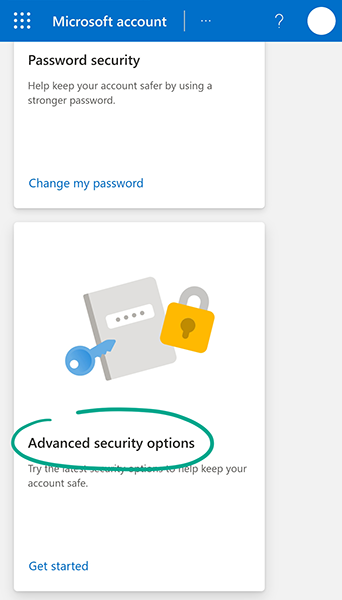
- Tap Done to turn on two-factor authentication. You do not need to enter your phone number or e-mail address: Number and e-mail from your account will be used, and you can choose between a text message and an e-mail each time you sign in.
After this, the system will prompt you for a security code whenever you sign in to Skype or other accounts linked to your Microsoft account.
How to hide your data from prying eyes
What for: To keep Microsoft from knowing where you go.
Skype may send information about your location to Bing for more relevant search results. This feature is disabled by default, but we still recommend checking the settings:
- Tap your profile picture;
- Select Settings;
- Go to the Privacy section;
- Turn off the Share location with Bing option.

What for: So that strangers do not know too much about you.
Personal information in your profile may be visible to unwanted users or even fraudsters who can use it for phishing scams. To delete private information from your account:
- Tap your profile picture;
- Select Settings;
- Go to the Account & Profile section;
- Select Your profile;

- If you previously indicated your real name but no longer want other users to see it, edit the Name field;
- Delete information from the following fields:
- About me;
- Gender;
- Birthday;
- City;
- State/region;
- Country/region;
- Mobile phone;
- Home phone;
- Office phone;
- Delete all e-mail addresses except your primary one;
- Tap Save Changes.
Downside: Your friends will have a harder time finding you in Skype.
What for: To keep Microsoft and their partners from listening to your conversations.
The automatic translation feature lets you communicate with other users even if you do not know their language. To improve this service, Skype collects fragments (snippets) of your conversations and analyzes them automatically using machine learning algorithms. However, to increase the accuracy of recognition and translations, you can allow employees of Skype and its partners to listen to these snippets.
According to its developers, all data is encrypted and depersonalized, and the employees who work with this data have to sign a non-disclosure agreement.
This feature is disabled by default, but we still recommend checking the settings:
- Tap your profile picture;
- Select Settings;
- Go to the Privacy section;
- Select Voice clip contribution;
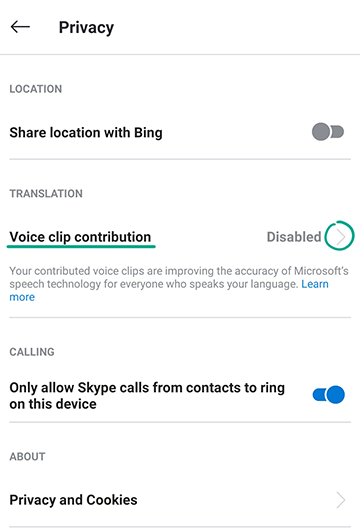
- Select No, do not contribute or Stop to contribute.
What for: To hide your profile from strangers.
Skype may show your profile to your contacts in search results and suggestions. If you do not want your profile to be seen by all users who have your phone number or e-mail address, turn off this feature:
- Tap your profile picture;
- Select Settings;
- Go to the Contacts section;

- Open the Privacy section;
- Turn off the Appear in search results option.
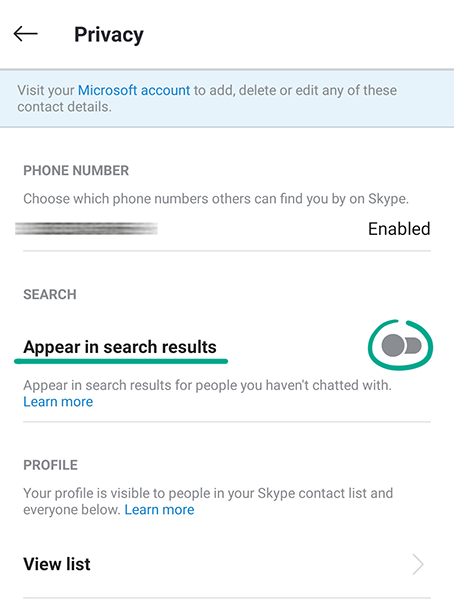
What for: To back up your important data.
By default, files from conversations, call logs and voice messages are stored on Skype servers for 30 days and then deleted. To save your important data, you can download it:
- Tap your profile picture;
- Select Settings;
- Go to the Account & Profile section;
- Select Your account;
- Scroll down the page and tap Settings and preferences;
- Tap Export files and chat history;

- Choose whether you want to download only your Skype chat history or all available files;
- Tap Submit request.
You can also download your contact list to keep in touch with your friends even if you lose access to your account. To download your Skype address book, in the Settings and preferences menu tap Export contacts (.csv).
What for: To prevent it from leaking.
Paid subscriptions let you use Skype to call mobile numbers and landlines. To top up your account, you can link a bank card or PayPal account to it. However, this information could be compromised by a data breach. To eliminate this risk, delete your bank card and PayPal account data:
- Tap your profile picture;
- Select Settings;
- Go to the Account & Profile section;
- Select Your account;

- Scroll down the page and tap Billing and payments;

- Select Payment methods;
- Tap Delete under the cards and accounts you want to unlink from your account.
What for: To keep Microsoft from knowing who you talk to.
During installation, Skype requests access to your contact list to simplify finding your friends. However, this information is also used to recommend your profile to people from your contact list. If you do not want to share this information, disable access to it:
- Tap your profile picture;
- Select Settings;
- Go to the Contacts section;
- Turn off the Sync your contacts option.
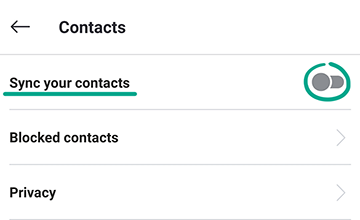
How to avoid annoying distractions in Skype
What for: To avoid unwanted communication.
By default, any Skype user can call you. If you do not want to be bothered by strangers, block calls from anyone not in your contact list:
- Tap your profile picture;
- Select Settings;
- Go to the Privacy section;
- Turn on Only allow Skype calls from contacts to ring on this device.

What for: To avoid unpleasant people.
If your contact list contains people who write offensive messages, distribute spam, or are just annoying, you can block them. Blocked contacts cannot call or message you. To blacklist (block) a user:
- Find their profile in your Skype contact list;
- Tap and hold the contact's photo. A menu will open;
- Select View profile;
- Tap Block contact.
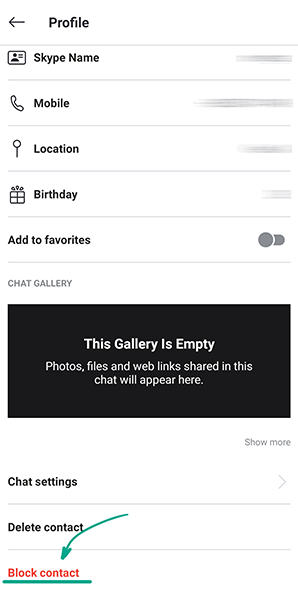
- Tap Block.
Blocked users will not know you’ve blacklisted them.
What for: To keep pranksters and scammers away from you and your family.
Skype can automatically answer all incoming calls. This feature is convenient for senior citizens. However, it can also be abused by scammers and pranksters. If your family is being bothered by suspicious people, instead of disabling automatic answer you can configure the application on their devices to only allow calls from people on the contact list.
To disable automatic answer:
- Tap your profile picture;
- Select Settings;
- Go to the Calling section;

- Turn off the Answer incoming calls automatically option.
What for: Less distraction.
Skype may send you notifications about incoming messages, surveys, and ads. If you are bothered by frequent notifications, you can completely or partially disable them:
- Tap your profile picture;
- Select Settings;
- Go to the Notifications section;

- Disable the unwanted notifications.






